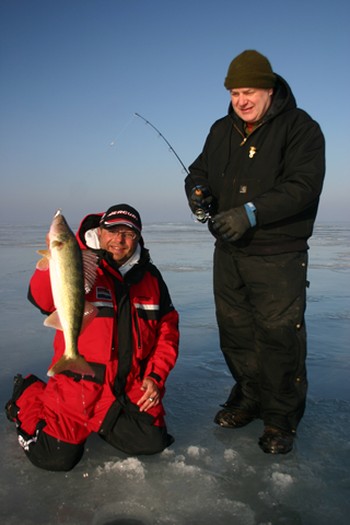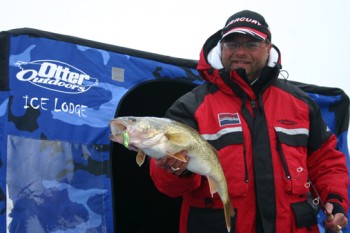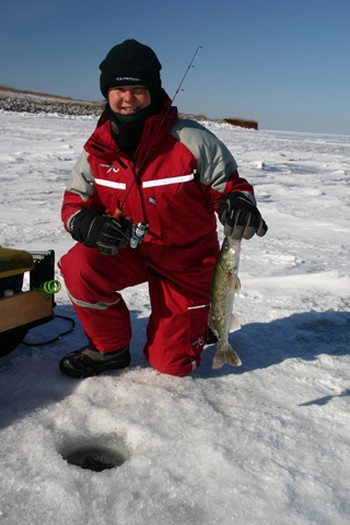Icing Walleye Is Nice-When You Think Safety First
Category: article
Dec 15th, 2010 by OutdoorsFIRST
Modified Dec 15th, 2010 at 12:00 AM
When AIM pro Mark Martin finally puts his Pro Walleye Series™ boat away for winter, his second walleye season’s just beginning.
 |
|
| Mark Martin helps a fishing school student land a Saginaw Bay walleye. |
Like many of AIM’s competitors, Martin likes to keep his fishing senses sharp in the hard water season, too, by nailing ’em through the ice on both his home inland water near Twin Lake, Michigan, as well as the big water like Lake Huron’s Saginaw Bay. That bay’s reputation as a great walleye producer has grown in stature over the last 10 years so much that it’s now considered one of the top spots in the country, winter or summer.
But while he’s eager to get onto the ice, Martin’s also not too eager to forget the first, second and third rules of ice fishing: Safety first, safety first, and lastly, safety first.
“That’s THE most important thing we teach, on top of how to catch walleye through the ice, and instructing them on how to operate their electronics,” Martin says. The “them” in that sentence are the 25 or so anglers who participate in his annual Ice Fishing Vacation/School every February. Now in its second decade, it’s considered the most successful school of its kind. In the past, Martin has taken anglers fishing across the state, from Michigan’s Upper Peninsula, to the last several class sessions, on the ice of Saginaw Bay.
And like any frozen water body, if you’re not careful, Saginaw Bay will tear you up if you’re not ready for not only what you know is waiting for you, but what you don’t know as well.
Preparation is the key before even setting one boot onto the ice, he said. “Ice fishing is all about using common sense,” Martin says.
If you’re planning to head onto the ice this winter, here’s a rundown of what Martin considers should be the most important items on your safety checklist:
–Wear proper clothing. Cotton-based outerwear won’t get it done when you’re dealing with sub-freezing temperatures both under the ice and above. Invest in a good set of waterproof clothing, from head to toe. “You might be drilling holes and have water splash on you, and if it soaks through you’re going to get really cold really fast, and if you’re out a ways, you can’t go back to your car and get warm,” he says.
Martin relies on Ice Armor outerwear. It’s lightweight and waterproof right down to his gloves and boots. “If you don’t have waterproof gear, and it’s below freezing on the ice with a howling wind comes up, you’re a candidate for hypothermia. You’ll not only get cold but disoriented, and if you’re by yourself, things can happen quickly that you might not want to happen,” he advises.
 |
|
| Mark Martin with a hefty Saginaw Bay walleye caught through the ice. |
–Don’t go alone, and follow tracks others have made. “This is so crucial. Play it safe, and you’ll have a lot of time to fish. I always tell my students, the fish don’t bite until you get there, so don’t be in a hurry. There are guys who do go out alone but if you want to go out and be Magellan or Columbus and try a route no one’s been on, there’s usually a good reason no one’s been there-unsafe ice.
“During one of our schools one year there was open water at one spot we’d seen the day before, that the next day was frozen with snow on top. It was probably maybe a half-inch thick. We knew it was there so we drove a half-mile around it, but these three four-wheelers who weren’t with us saw our group and had to fish near us. Well they were so intent getting to us to fish, they went through that thin spot they didn’t know was there, and went right in. They weren’t using the path they should have been on and went straight toward us instead,” he said. “Thank goodness a local guy was there with an airboat to pull them out. If you aren’t out there every day, stick to the trails and travel single file with plenty of space between.”
–Bring along chemical handwarmers. “If your hands get cold at least you’ve got a source of warm in each pocket.
And on the ice, size matters when it comes to warmers, he says. “The smaller packets don’t last long, and don’t give off much warmth. The larger ones last for 12-plus hours. Martin recommends putting some in your boots as well, but not before you settle in on the ice.
“Before you go out, you’ll be moving around getting ready. It’s when you’re stationary that you need them. Put them in both your toes and your heel so you’ll warm the entire foot,” he says. Don’t put them in when you start because your feet will sweat, and your boots will have so much moisture in the felt or socks they will get cold later and warmers won’t be of much use.” Martin has another tip: bring along a small piece of flat foam home insulation to place on the ice under your boots. It’s a great way to keep your feet off direct contact with the ice.
–Bring along a GPS or phone with GPS included, plus a compass. They’re literally life-savers. You can track the way you took out so you don’t wander into dangerous territory, and if the wind creates whiteout conditions, they’ll get you back to land safely. With a compass, take a reading before you leave shore, and when you arrive at your spot, so you know how to return.
“I’ve been out with film crews doing television shows and the wind blew so much we could no longer see shore. It probably showed a foot-and-a-half by the time we left, and we had to rely on our GPS to get back,” Martin says.
 |
|
| Mark Martin’s ice fishing school also draws women anglers. Denise Semion holds a Saginaw Bay walleye taken on a jigging Rapala. |
–Wear sunglasses to prevent snowblindness. Wear hand-held ice picks strung around your neck on a rope, so if you do go in, you can claw your way out of the water using the picks, or throw them to someone in trouble.
–Always carry an old-fashioned ice spud. You’ll be using it not to spud a hole, but to test the ice in front of you before you put your full body weight on it, Martin says. And on larger water bodies, ice can shift and build into overlapping cracks you can’t drive around or over. “So, you’ve got to chisel them down so you can drive cross. Or, sometimes a crack opens and you need to make a bridge out of the ice around to fill in the cracks. A simple thing like a spud can save your life,” he says.
–Read the ice. Martin says that remembering where the cracks were that weren’t a problem going out but might be coming in, also is a life-saver. “As I go I make notes on my Lowrance GPS where the cracks are so if there’s a wind shift and it’s opened up, I can follow the crack down to where it’s pushing together and get across. Many hand-held GPS units now can be charged by your snow machine or four-wheeler.
–Make sure you snowmobile or four-wheeler is in top condition and bring spare equipment. For snowmobiles, that means an extra belt. For four-wheelers, a tire repair kit. “It’s stuff you could have at all times anyway, like carrying a spare tire in your car’s trunk. And that also means carrying extra batteries for your GPS, packed close to your skin, inside a coat or shirt, and not exposed to cold.
Other common sense equipment to take includes a flashlight or headlamp, drinking water and emergency food bars and first-aid kit. Lastly, let someone on shore know your plans, where you’ll be fishing and when you plan to return.
Following some simple rules, Martin concludes, will make your ice fishing experience one you’ll want to repeat again and again.
For information on Martin’s ice fishing school, go to:
www.fishingvacationschool.com/icefishing.
Martin will cover proper fishing equipment in a future article.